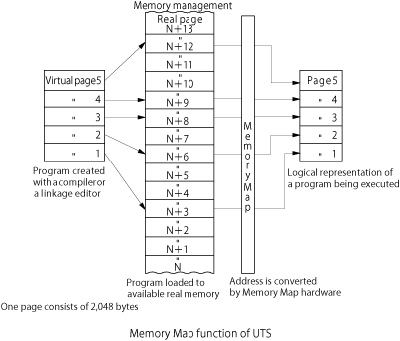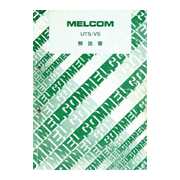UTS/VS was an operating system developed by Mitsubishi Electric for the COSMO series general-purpose computers announced in 1974. It succeeded and strengthened the operating systems of MELCOM-7000. In addition to the enhancement of batch processing, interactive time-sharing processing, remote processing that allowed an extensive computer network, and sensor-based critical real-time processing, all of which were notable features of MELCOM-7000, online transaction processing that allowed immediate access and updating of an online database was supported. These five modes of operation were simultaneously and concurrently executed by UTS/VS.
1. Processing modes
- (1) Batch processing
- Batch jobs were concurrently executed in up to 16 logical partitions created when the system was generated. Each partition had an independent virtual space. The switchover between partitions was based on time slicing.
- (2) Time-sharing processing
- Up to 128 interactive terminals were supported. Both of private lines and public lines were available for its communication. Users could use the same functions as those in batch processing. FORTRAN IV and COBOL programs could be used without change, and interactive debugging packages for them were additionally provided. The interactive processors included BASIC and APL. Submission of batch jobs and queries on their status and the communication with operators were also available.
- (3) Remote processing
- Standard remote batch terminals (RBT) as well as intelligent remote batch terminals (IRBT) that had data processing functions were supported. IRBT adopted the IBM HASP multi-leaving method, enabling establishment of a network with a computer that had an HASP transmission protocol.
- (4) Real-time processing
- It was possible for a real-time program to reside on the main memory and to start its execution in a few microseconds after hardware interrupts with a hardware mechanism; no intervention of a scheduler program is required.
- (5) Transaction processing
- The user could easily build a desired online system that automatically performed data collection, database search, updating, report creation, etc. simply by inputting a message from a terminal. In addition, the user could automatically acquire a journal of I/O messages at various stages of processing, and utilize the journal for failure recovery and statistical processing.
2. Functions of the operating system
- (1) Storage management
- User programs were stored in free areas on the main memory which were managed in pages (one page = 2,048 bytes). The memory address designated by the program was a virtual address. It was converted into a real address by a hardware mechanism called “Memory Map” when the program was executed.




